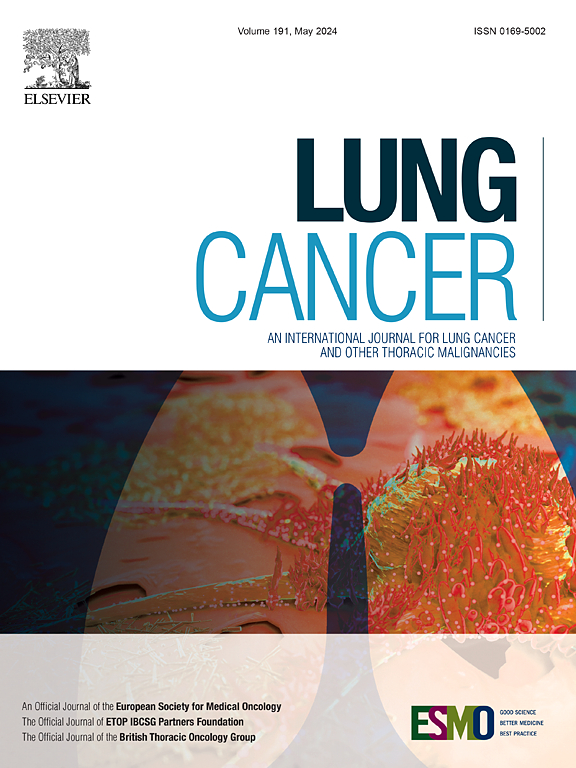Impact of tumor cell burden beyond the elastic layer on prognosis in T2aN0M0 non-small cell lung cancer with visceral pleural invasion
IF 4.4
2区 医学
Q1 ONCOLOGY
引用次数: 0
Abstract
Objectives
Visceral pleural invasion (VPI) is a key upstaging T-factor in non-small cell lung cancer (NSCLC). This study aimed to investigate the prognostic significance of VPI patterns.
Material and Methods
We retrospectively analyzed 107 participants pathologically diagnosed NSCLC (T2aN0M0) with VPI. Five VPI patterns were quantitatively evaluated and analyzed for their survival impact: (1) total tumor cell area beyond the elastic layer (TCA), (2) whole tumor area beyond the elastic layer (WTA), (3) minimum distance from the pleural surface to the tumor cell invading the pleura (min-DST), (4) maximum distance from the pleural surface to the deepest point of the invaginated elastic layer (max-DSI), and (5) density of tumor cells (DTC).
Results
Median values for TCA, WTA, min-DST, max-DSI, and DTC were 353,471 μm2, 2,370,436 μm2, 114 μm, 1,248 μm, and 19.2 %. Five-year recurrence-free survival (RFS) was significantly lower in participants with larger TCA and WTA (log-rank test). In univariable Cox regression analysis, smoking status, Eastern Cooperative Oncology Group performance status (ECOG PS), invasive component size, TCA, and WTA were significant predictors of RFS. In multivariable analysis, ECOG PS [HR = 2.475; 95 % CI, 1.049–5.838], invasive component size [HR = 2.347; 95 % CI, 1.137–4.845], and TCA [HR = 3.574; 95 % CI, 1.318–9.695] remained independent significant prognostic factors for RFS.
Conclusion
TCA may serve as a novel prognostic factor in NSCLC with VPI.
弹性层外肿瘤细胞负荷对T2aN0M0型非小细胞肺癌内脏性胸膜浸润患者预后的影响
目的内脏胸膜浸润(VPI)是非小细胞肺癌(NSCLC)的一个关键的前期t因子。本研究旨在探讨VPI模式的预后意义。材料和方法我们回顾性分析了107例病理诊断为NSCLC (T2aN0M0)的VPI患者。定量评价和分析五种VPI模式对生存的影响:(1)肿瘤细胞总弹性层外面积(TCA),(2)整个肿瘤弹性层外面积(WTA),(3)从胸膜表面到侵袭胸膜的肿瘤细胞的最小距离(min-DST),(4)胸膜表面到内陷弹性层最深点的最大距离(max-DSI),(5)肿瘤细胞密度(DTC)。结果TCA、WTA、min-DST、max-DSI和DTC的中位数分别为353,471 μm2、2,370,436 μm2、114 μm、1,248 μm,分别为19.2%。在TCA和WTA较大的参与者中,5年无复发生存率(RFS)显著降低(log-rank检验)。在单变量Cox回归分析中,吸烟状况、东部肿瘤合作组表现状态(ECOG PS)、侵入性成分大小、TCA和WTA是RFS的显著预测因子。在多变量分析中,ECOG PS [HR = 2.475;95% CI, 1.049 ~ 5.838],侵入性成分大小[HR = 2.347;95% CI, 1.137-4.845], TCA [HR = 3.574;95% CI(1.318-9.695)仍然是RFS的独立重要预后因素。结论tca可能是NSCLC合并VPI的一个新的预后因素。
本文章由计算机程序翻译,如有差异,请以英文原文为准。
求助全文
约1分钟内获得全文
求助全文
来源期刊

Lung Cancer
医学-呼吸系统
CiteScore
9.40
自引率
3.80%
发文量
407
审稿时长
25 days
期刊介绍:
Lung Cancer is an international publication covering the clinical, translational and basic science of malignancies of the lung and chest region.Original research articles, early reports, review articles, editorials and correspondence covering the prevention, epidemiology and etiology, basic biology, pathology, clinical assessment, surgery, chemotherapy, radiotherapy, combined treatment modalities, other treatment modalities and outcomes of lung cancer are welcome.
 求助内容:
求助内容: 应助结果提醒方式:
应助结果提醒方式:


